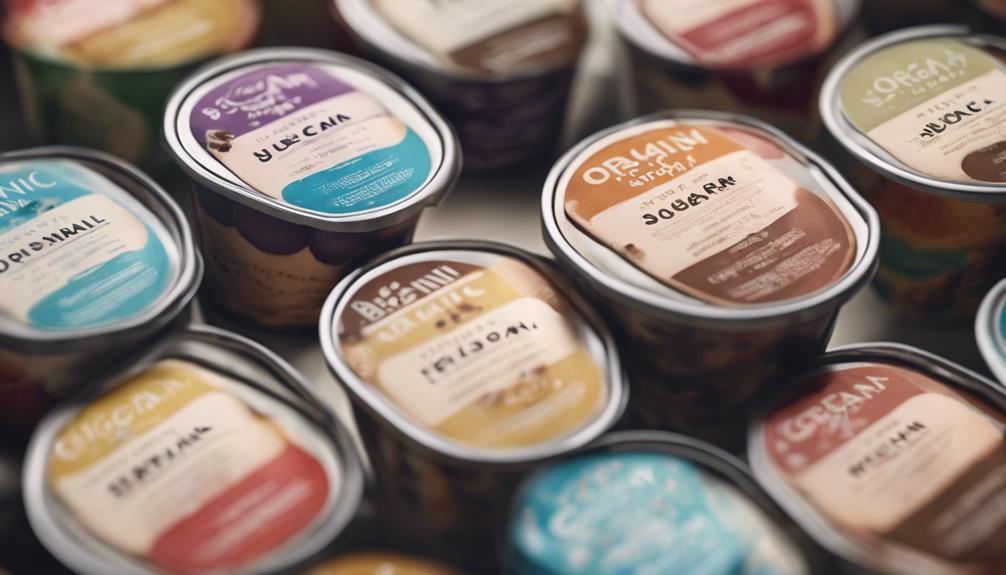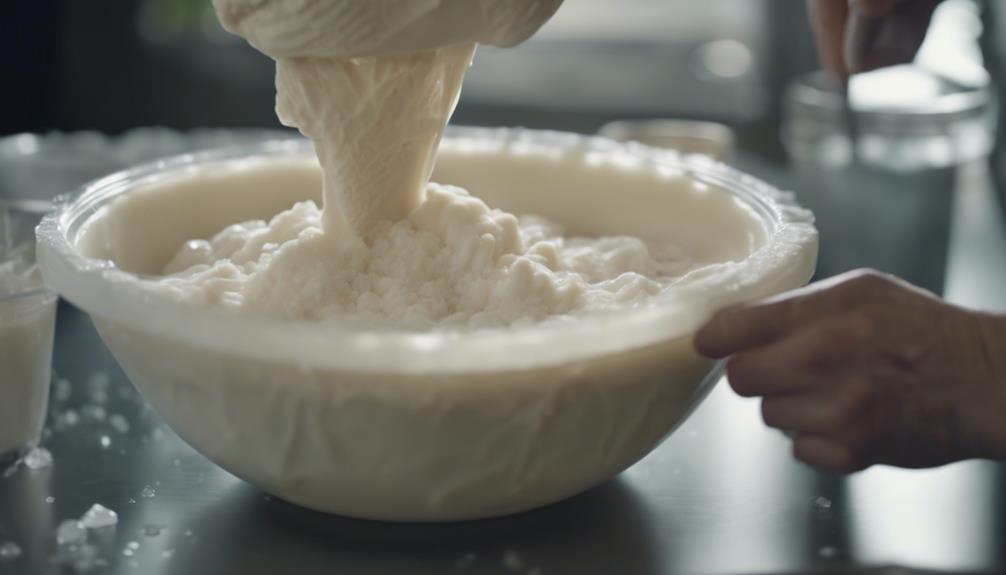Frozen Delights
Understanding Ice Cream Labels: What You Need to Know!
Lick your way to ice cream enlightenment by uncovering the secrets behind labels, ensuring guilt-free indulgence with every scoop.

When browsing ice cream labels, grasp terms like reduced fat, light, low-fat, and non-fat for insight into the nutritional value of your icy delight. Understand these terms to choose wisely and savor your frozen treat guilt-free. Explore how fat levels influence taste and quality. By knowing the label lingo, you can select the perfect scoop for your cravings. Get a scoop on sugar content and fat breakdown for smarter dietary decisions. Make your ice cream moments both delicious and mindful by decoding those labels. Learn to decipher the labels and elevate your ice cream experience.
Key Takeaways
- Differentiate terms like reduced fat, light, low-fat, and non-fat as per FDA guidelines.
- Analyze sugar content for dietary decisions.
- Understand varying fat contents for health goals.
- Identify quality segments based on fat, air content, and ingredients.
- Importance of label reading for informed choices and weight management.
Labeling Definitions

Understanding ice cream labels begins with grasping the defined terms used to categorize different fat content variations. When it comes to fat content, ice cream labels often feature terms like reduced fat, light, low-fat, and non-fat, all of which are carefully defined by the FDA.
For example, reduced fat ice cream must contain at least 25% less fat than its full-fat counterpart, providing consumers with a clear understanding of the product they're choosing. By familiarizing yourself with these labeling definitions, you can make informed decisions that align with your dietary preferences and health goals.
Whether you're aiming to indulge in a creamy treat with lower fat content or seeking a healthier alternative, knowing the ins and outs of ice cream labeling can help you navigate the frozen dessert aisle with confidence and clarity.
Quality Segments

Quality sections in the ice cream industry categorize products based on factors like fat content, air content, and ingredients, enabling consumers to make informed choices based on their preferences for richness and overall quality.
Milkfat content plays a vital role in determining the quality section of ice cream. Superpremium ice cream, for example, is recognized for its low overrun and high fat content, resulting in a rich and creamy texture. Federal standards also oversee the overrun in ice cream to uphold consistency in quality.
By understanding these quality sections, consumers can choose ice cream products that best match their taste preferences. Whether you fancy a luxuriously creamy ice cream with high milkfat content or a lighter alternative with lower fat content, knowing the quality sections can steer you towards the ideal choice for your next frozen treat craving.
Next, let's explore how sugar content analysis can further aid you in making informed decisions when selecting ice cream products.
Sugar Content Analysis

Analyzing the sugar content in ice cream can assist you in making informed dietary choices based on your preferences and nutritional needs. When looking at ice cream labels, keep in mind that 'no sugar added' ice cream retains the original ingredient sugars, while 'sugar free' ice cream must contain less than 0.5 grams of sugar per serving.
Achieving sugar free status in ice cream that contains fruit or nuts can be challenging due to the presence of natural sugars. Understanding the difference between sugar free and no sugar added options is essential for making informed decisions about your ice cream consumption.
Choosing sugar free ice cream can offer health benefits by reducing your overall sugar intake and potentially aiding in weight management. Manufacturers are continuously working on improving sugar free ice cream options to provide tasty alternatives without compromising quality.
Fat Content Breakdown

When it comes to ice cream labels, understanding the fat content breakdown is essential for making informed dietary choices. Different fat content levels cater to varying dietary considerations, allowing you to select the option that aligns with your health goals.
Whether you opt for light, low-fat, or regular ice cream, knowing the fat content breakdown empowers you to make mindful decisions about your ice cream consumption.
Fat Content Importance
How significant is the fat content breakdown when examining different types of ice cream? Understanding the fat content in ice cream is essential as it directly impacts the richness and creaminess of the product.
Here are some key points to keep in mind:
- Light or Reduced Fat Ice Creams: These options have a lower fat content compared to regular ice creams, making them suitable for individuals monitoring their fat intake.
- Low-Fat Ice Creams: With even less fat than light variants, low-fat ice creams provide a lighter alternative while still offering a satisfying treat.
- Regular Ice Creams: Regular ice creams contain a higher fat content due to the addition of cream, resulting in a creamier texture and richer taste experience.
Taking into account the fat content breakdown allows you to make informed choices based on your dietary preferences and health goals.
Whether you choose a lighter option or indulge in a richer treat, understanding the fat content in ice cream is essential to enjoying your frozen dessert to the fullest.
Dietary Considerations
Understanding the fat content breakdown in ice cream is crucial for making informed dietary choices. When checking the nutritional values on ice cream labels, look for the grams of total fat per serving.
Light or reduced-fat ice creams typically have less fat than regular options, offering a lower calorie alternative. If you're watching your fat intake, low-fat ice creams are even more suitable with their decreased fat content.
Regular ice creams, on the other hand, boast a richer flavor profile due to their higher fat content from cream. For those seeking minimal fat content, very low or no fat ice creams fall into the category of ice milk.
It's worth mentioning that achieving low or no fat content in ice cream can be challenging due to the inherent fat concentration in cream. By being mindful of the fat content breakdown, you can choose an ice cream option that aligns with your dietary preferences and health goals.
Calcium Fortification Benefits

When it comes to ice cream labels, understanding the benefits of calcium fortification is key.
Calcium-rich ice cream can greatly contribute to your bone health.
Calcium-Rich Ice Cream
Ice cream enhanced with calcium provides additional benefits for bone health, making it a valuable choice for individuals concerned about their calcium intake. Calcium-rich ice cream, including dairy products, offers a convenient way to boost your calcium consumption.
Here are three key points to keep in mind:
- Naturally Rich in Calcium: Ice cream is naturally abundant in calcium, making it a good source of this essential mineral.
- Bone Health Benefits: Calcium-fortified ice creams provide extra support for bone health, which is particularly advantageous for individuals worried about osteoporosis.
- Convenient Calcium Boost: Opting for calcium-fortified ice cream can be a simple way to enhance your calcium intake, a particularly helpful option for children and teens.
Choosing calcium-fortified ice cream may involve a slightly higher cost, but the long-term advantages for your health outweigh the additional expense.
Health Benefits Emphasized
Enhancing ice cream with calcium fortification significantly boosts its nutritional value, offering remarkable health benefits for consumers. Calcium-fortified ice creams provide a convenient way to increase daily calcium intake, benefiting bone health and catering to individuals concerned about osteoporosis. While these fortified options may be slightly pricier, the long-term health advantages they offer make them a worthwhile investment, especially for children and teens whose bone development is essential.
To help you understand the significance of calcium-fortified ice creams, here is a table highlighting the key health benefits:
| Health Benefits | Description |
|---|---|
| Stronger Bones | Calcium in fortified ice cream aids in maintaining bone density and strength. |
| Osteoporosis Prevention | Regular consumption can help prevent osteoporosis, particularly in older adults. |
| Daily Calcium Intake | Convenient way to supplement your daily calcium needs, especially if lacking in diet. |
| Suitable for All Ages | Ideal for children, teens, and adults looking to boost their calcium intake. |
Informed Consumer Choices

Understanding ice cream labels empowers you to make informed choices for healthier and more enjoyable dessert experiences. By reading and comprehending the information on ice cream labels, you can take control of your consumption habits and select products that align with your dietary needs and preferences.
- Consider Nutritional Information: Pay attention to the sugar and fat content listed on ice cream labels to make informed decisions about the products you choose.
- Dietary Restrictions: Understanding ice cream labels can help you identify products that meet your dietary restrictions, such as gluten-free, dairy-free, or vegan options.
- Weight-Loss Goals: Being informed about the nutritional content of ice cream can support your weight-loss goals by allowing you to make conscious choices about portion sizes and calorie intake.
Making informed choices when it comes to ice cream can enhance your overall dessert experiences and contribute to a healthier lifestyle. So, next time you're at the grocery store, take a moment to read the labels and make choices that align with your health and wellness goals.
Importance of Label Reading

Label reading plays a pivotal role in making informed decisions about the ice cream products you consume. When it comes to ice cream, understanding the ingredients listed on the label is essential for your health and well-being.
By taking the time to read the label, you can avoid allergens that may trigger adverse reactions, such as nuts or gluten, which are often highlighted for easy identification. Additionally, being aware of additives, thickeners, and artificial colors in ice cream ingredients can help you choose products that align with your dietary preferences and health goals.
Keep an eye out for complex names or ingredients marked with the letter E, as these could indicate potentially harmful additives.
In essence, reading ice cream labels empowers you to make conscious choices that suit your needs and preferences. Next time you're at the ice cream parlor, take a moment to scan the label and make a well-informed decision about the frozen treat you're about to enjoy.
Galatea's Natural Ingredients Commitment

Galatea's commitment to using natural ingredients has been a cornerstone of their approach since 2006. When it comes to their ice cream, they prioritize clean labels by incorporating natural ingredients like plant extracts and concentrates to enhance the overall product quality.
Here are some key points about Galatea's natural ingredients commitment:
- Plant-Based Dyeing: Galatea avoids artificial colors and opts for natural dyeing using plant extracts such as spirulina and safflower, providing a healthier alternative.
- Product Variety: Their product lines cater to different dietary preferences, including the Libera line with only natural ingredients, an organic line consisting of at least 95% organic ingredients, and a vegan line free from animal-based products and GMO raw materials.
- Ethical Practices: Galatea's commitment extends to ethical practices, offering an ethical line that features nutritionally healthy products without hydrogenated fats and non-natural ingredients.
Galatea's artisanal ice cream stands out for its high-quality ingredients, natural coloring, and sustainability efforts, setting a standard for clean labels in the industry.
Dairy Product Labeling Requirements

When labeling dairy products, make sure that key information such as the sales name, net quantity, use-by date, storage conditions, and batch number is prominently displayed. Additionally, it's essential to include the total fat per serving and allergen information on ice cream labels to inform consumers with dietary restrictions or allergies.
Checking for additives, thickeners, artificial colors, and avoiding ingredients with complex names or E numbers can help you make healthier choices when selecting dairy products. Meeting European Union regulations (1169/2011), dairy product labels aim to provide clear information for consumer safety and understanding.
Frequently Asked Questions
What Are the 4 Categories of Ice Cream?
Ice cream comes in four categories: regular, reduced fat, light, and non-fat. Each type varies in fat content to cater to different dietary needs. Understanding these categories helps you choose the ice cream that suits your preferences.
How Can You Tell if Ice Cream Is High Quality?
You sense quality ice cream by its low overrun, rich flavor, and premium ingredients. Seek labels like super-premium or premium. Look for low air content, high fat, and natural ingredients. Federal standards guarantee consistency.
What Is the Basic Knowledge of Ice Cream?
To understand ice cream basics, consider its types, fat content importance, and premium varieties. Federal standards guarantee consistent labeling. Definitions like reduced fat or nonfat aid in choosing. Knowing these aspects helps you make informed decisions.
What Are the FDA Requirements for Ice Cream?
To know the FDA requirements for ice cream, verify labels meet federal regulations. Ice cream must have a minimum milkfat content of 10%. Reduced fat, light, lowfat, and nonfat ice creams have specific fat criteria set by the FDA.
Conclusion
So next time you're browsing the ice cream aisle, remember to read the labels like a detective searching for clues.
Just like a compass guides you in the right direction, labels can help you make informed choices about what you're putting into your body.
With a little bit of label reading, you can guarantee you're enjoying a delicious treat that meets your dietary preferences and health goals.
Happy ice cream hunting!
As the Editor-in-Chief, Sara ensures that every piece of content published on the website is informative, engaging, and easy to follow. She believes in empowering readers to explore their creativity and experiment with various flavors and toppings. Sara’s step-by-step guides and clear instructions enable ice cream enthusiasts to create their own customized masterpieces that will impress friends and family.
With a wealth of experience in the culinary world, Sara brings a creative touch to Dri Dri Gelato’s content. She understands that ice cream is more than just a dessert—it’s a delightful experience that can bring joy and excitement to any occasion. Sara’s expertise lies in not only creating delicious ice cream recipes but also in teaching others the art of making ice cream at home, from the basics to the more advanced techniques.
Frozen Delights
How to Make Ice Cream in 5 Minutes Without an Ice Cream Maker – Genius!
Fulfill your craving for homemade ice cream in just 5 minutes without an ice cream maker – discover the secret to quick and delicious frozen treats!

You can make ice cream in just 5 minutes without an ice cream maker! Grab a blender, heavy cream, milk, sugar, and vanilla extract. Chill the mix, then blend it until creamy. Experiment with flavors like lemon curd or caramel. Enhance texture by using a food processor. Customize with mix-ins like chocolate or nuts. The possibilities are endless when making homemade ice cream without a machine!
Key Takeaways
- Use a blender for quick ice cream without a machine.
- Combine heavy cream, sweetened condensed milk, and vanilla extract.
- Blend until smooth, then freeze for 5 minutes.
- Add mix-ins like chocolate chips or fruit for variety.
- Enjoy creamy, homemade ice cream in minutes!
Ice Cream Making Techniques

To make ice cream without an ice cream maker, you can utilize basic tools like a blender or Kitchen Aid mixer. For a classic Vanilla Ice Cream, start by making the ice cream base with ingredients like heavy cream, milk, sugar, and vanilla extract.
Mix these ingredients until smooth, then chill the mixture in the refrigerator for a few hours. Once chilled, pour the mixture into your chosen tool, and begin the churning process.
Stir the mixture every 30 minutes to prevent ice crystals from forming, ensuring a creamy texture. If using a blender, blend the partially frozen mixture to incorporate more air and create a lighter consistency.
This technique is also applicable when making Chocolate Ice Cream or other flavors. By incorporating air during the freezing process and monitoring the mixture closely, you can achieve delicious homemade ice cream without the need for a specialized machine.
Equipment and Substitutions

Consider utilizing everyday kitchen tools as substitutes for an ice cream maker when making homemade ice cream. If you don't have an ice cream maker, a hand mixer, stick blender, or a whisk can be used to churn your ice cream mixture effectively.
For a fun twist, pour your custard base into popsicle molds for a unique presentation and a revitalizing treat. Experimenting with flavor additions like lemon curd or using melted store-bought caramels can result in delicious and inventive variations of your ice cream.
These substitutions not only offer convenience but also allow for customization based on your preferences and dietary needs. Whether you're looking to try new flavors or cater to specific dietary restrictions, making ice cream without a dedicated machine opens up a world of possibilities for creativity in the kitchen.
Texture Improvement

Experiment with different kitchen tools like a food processor or immersion blender to enhance the texture of your homemade ice cream when making it without an ice cream maker. Churning the ice cream in a machine typically yields a smoother texture with fewer ice crystals compared to hand mixing.
By whirling your ice cream in a food processor, you can boost its creaminess and overall texture. This method allows for experimentation, giving you the flexibility to achieve your desired consistency.
Testimonials and Feedback

Users praise the quick and efficient method of making ice cream in just 5 minutes without an ice cream maker. The feedback has been overwhelmingly positive, with users expressing their love for making ice cream using this method.
Here are some key points from the testimonials:
- Delicious Results: Users are delighted with how their ice cream turned out using this method.
- Variety of Recipes: Many users are enthusiastic to try out new ice cream recipes using this quick technique.
- Easy and Accessible: Users appreciate the simplicity and accessibility of making homemade ice cream without a machine.
The testimonials highlight the satisfaction users have experienced by creating scrumptious ice cream in a short amount of time. With the positive feedback received, many are keen to explore different flavor combinations and ice cream recipes to try out next.
Ingredients, Equipment, Recipe Variations

To create homemade ice cream without an ice cream maker, gather minimal ingredients like milk, sugar, and vanilla for a quick and easy dessert. You won't need a fancy machine; just a sealed bag with ice and salt for a DIY churn. Customize your ice cream by adding mix-ins like chocolate or nuts for a personalized touch. Below is a table outlining the key ingredients and equipment needed for this simple ice cream-making process:
| Ingredient | Quantity | Usage |
|---|---|---|
| Milk | 1 cup | Base of ice cream |
| Sugar | 1/4 cup | Sweetening agent |
| Vanilla | 1 tsp | Flavor enhancement |
| Salt | 1/2 cup | Aids in freezing process |
| Chocolate | Optional | For a chocolate twist |
Feel free to experiment with different flavors and mix-ins to create your perfect homemade ice cream. Enjoy the creamy goodness in just a few minutes without the need for a traditional ice cream maker.
Frequently Asked Questions
How to Make Ice Cream Without an Ice Cream Maker in 5 Minutes?
To make ice cream without an ice cream maker in 5 minutes, crush dry ice finely, blend it with your ice cream base using a tea towel, and stop adding dry ice when the temperature hits -5 degrees Celsius. Enjoy your quick frozen treat!
How to Make Ice Cream in 10 Minutes?
You can make ice cream in 10 minutes by shaking a sealed bag of ingredients in ice and salt. Incorporate air for a creamy texture. Customize flavors and mix-ins. Enjoy homemade ice cream without an ice cream maker.
What Can I Use if I Don't Have a Ice Cream Maker?
If you don't have an ice cream maker, try using a blender, hand mixer, or Kitchen Aid mixer as alternatives. Get creative by pouring custards into popsicle molds or experimenting with different flavors like lemon curd or store-bought caramels.
How Do You Churn Icecream by Hand?
To churn ice cream by hand, simply stir and scrape the mixture as it freezes. Break up ice crystals and incorporate air by stirring continuously for about 20-30 minutes. Check and stir regularly for a smooth texture.
Can I Use the 5 Minute Ice Cream Method with an Ice Cream Maker?
Yes, you can use the 5 minute ice cream method with an ice cream maker. Simply follow the recipe as directed and pour the mixture into your top ice cream maker picks. The machine will churn the mixture, resulting in creamy, delicious ice cream in no time. Enjoy the quick and easy homemade treat!
Conclusion
In just 5 minutes, you can whip up a delicious homemade ice cream without the need for an ice cream maker.
With a few simple ingredients and a little creativity, you can create a frozen treat that rivals any store-bought option.
So why wait? Get ready to scoop up a creamy, dreamy dessert that will have you feeling like a culinary genius in no time!
Mario’s creativity shines through his ability to describe the sensory experience of enjoying ice cream. Whether he’s discussing the velvety texture, the explosion of flavors, or the delightful combinations of toppings and sauces, his words transport readers to a world of mouthwatering sensations. His descriptive language allows readers to imagine and savor the flavors even before taking the first bite.
Frozen Delights
Discover the Ancient History of Ice Cream – You’ll Be Amazed
Nourish your curiosity with the surprising origins of ice cream and uncover its tantalizing journey through time.

Get ready to be amazed by the ancient roots of ice cream! From Turkish sherbets symbolizing hospitality to Italian gelato traditions, the journey of this sweet treat will captivate you. The impact of ice cream on colonial America and the evolution of the industry will surely intrigue you. And don't forget about George Washington's love for this frozen dessert! The fascinating history of ice cream is just the beginning of a delightful exploration into its enduring popularity and social impact. Discover more about the fascinating evolution of this beloved treat!
Key Takeaways
- Ice cream dates back to China in the 7th century with milk and rice.
- Roman Emperor Nero enjoyed a precursor made with snow, honey, and fruit.
- Persian royalty in the 5th century BC savored an early form made from rose water and vermicelli.
- Frozen desserts evolved in the Middle Ages with milk, cream, and flavors like orange blossom.
- Spread to Europe in the 16th century, leading to sorbets and ice creams.
Turkish Sherbet Origins

Turkish sherbet's origins can be traced back to the Islamic world, with the English term 'sherbet' deriving from the Turkish language. This invigorating beverage has a rich history intertwined with Islamic culture and culinary traditions. In Turkey, sherbet isn't only a drink but also a symbol of hospitality and celebration. The art of making Turkish sherbet involves blending fruit juices, flower extracts, and spices with water and sugar to create a flavorful concoction that's both sweet and aromatic.
Turkish sherbet served as the inspiration for many frozen desserts that followed, including sorbets and ice creams. Its popularity spread to other regions, influencing the development of similar frozen treats like faloodeh in Persia and kulfi in India.
The process of making Turkish sherbet wasn't only about quenching thirst but also about creating a sensory experience through the combination of different flavors and textures. Today, Turkish sherbet continues to be enjoyed for its unique taste and cultural significance.
Italian Ice Cream Innovations

Italian ice cream innovations have had a profound impact on the history of frozen desserts. Gelato traditions, historical sorbet varieties, and traditional milk sorbets all showcase Italy's rich contributions to the world of ice cream.
From the 17th century banquets to Antonio Latini's milk sorbet recipe, Italian influences have shaped the evolution of frozen treats across Europe.
Italian Gelato Traditions
With roots tracing back to early European frozen desserts, gelato traditions in Italy have a rich and influential history. Italian gelato traditions have long been intertwined with the evolution of frozen treats.
In the 1620s, water ice desserts were already documented in Italy, showcasing the country's early foray into frozen desserts. As ice cream gained popularity across Europe, Italy remained at the forefront of innovation. In 1672, King Charles II was served ice cream, further solidifying its status.
Additionally, Antonio Latini's publication of a milk sorbet recipe in 1694 emphasized Italy's role in shaping frozen dessert culture. By the mid-17th century, ice cream had become a staple at banquets in various European cities, highlighting Italy's rich gelato history.
The advancements in ice cream machines also played an essential role in the development of Italian gelato, allowing for smoother and creamier textures that are now synonymous with this beloved frozen treat.
Historical Sorbet Varieties
Early sorbet varieties, known for their invigorating fruit flavors and icy textures, have a fascinating history intertwined with the evolution of Italian ice cream innovations.
Italian ices were pioneers among European ice creams and water ices, originating from Italy's culinary advancements. As early as the 1620s, descriptions of water ice desserts emerged, marking the genesis of Italian ice treats.
The popularity and dissemination of Italian ice cream were evident when King Charles II indulged in ice cream in 1672. Antonio Latini's 1694 publication of a milk sorbet recipe further enriched the array of Italian ice cream varieties.
Traditional Milk Sorbets
Water ice desserts described in the 1620s paved the way for traditional milk sorbets, an integral part of Italian ice cream innovations since the 17th century. Italian ice cream history showcases the evolution of milk sorbets, with Antonio Latini's 1694 recipe playing a significant role.
By the mid-17th century, ice cream had become a sought-after delicacy at banquets across European cities, demonstrating the influence of Italian ice traditions. Italy, known for its early European ice cream and water ices, has been a key player in shaping the world of frozen desserts.
Milk sorbets, a creamy variation of traditional sorbets, added a new dimension to the evolving world of Italian ice cream. The incorporation of milk brought a richer texture and taste to these frozen treats, further enhancing their popularity among ice cream enthusiasts.
As Italian artisans refined their techniques over the centuries, milk sorbets continued to be a staple in the domain of frozen desserts, solidifying Italy's reputation as a hub of ice cream innovation.
Ice Cream Across the Atlantic

Ice cream made its journey across the Atlantic alongside European colonists, bringing this delightful treat to American shores. Founding Fathers like George Washington and Thomas Jefferson were known to savor the frozen dessert, contributing to its popularity in the newly established United States.
As the 19th century progressed, ice cream innovation flourished in America, paving the way for the introduction of diverse flavors and creations enjoyed by people across the nation.
Colonial Ice Cream Origins
Having crossed the Atlantic with European colonists, ice cream made its debut in colonial America as a luxurious dessert enjoyed by the elite. Making ice cream was a laborious process back then, involving the use of ice harvested during the winter months and a mixture of cream, sugar, and flavors. Below is a table showcasing some key points about the colonial origins of ice cream:
| Colonial Ice Cream Origins | |
|---|---|
| Introduction | With European colonists traversing the Atlantic |
| Adoption by Elite | Became a popular dessert among the elite |
| Early Recipes | Thomas Jefferson's French-style vanilla ice cream |
| Popularity Growth | Continued to rise in late 19th century America |
| Innovation | Led to new flavors and variations |
Ice cream's presence in colonial America, enjoyed by figures like George Washington and Thomas Jefferson, marked the beginning of a sweet journey that would lead to the diverse world of frozen treats in present times.
Founding Fathers' Preferences
George Washington and Thomas Jefferson, two prominent figures in early American history, indulged in ice cream as a favored dessert, showcasing their preferences for this frozen treat that crossed the Atlantic with European colonists. The Founding Fathers' love for ice cream not only reflected their refined tastes but also helped popularize this sweet delicacy in the budding nation. Here's why their affinity for ice cream is particularly intriguing:
- Historical Significance: Their enjoyment of ice cream offers a glimpse into the culinary habits of the elite during colonial times.
- Cultural Influence: The Founding Fathers' endorsement of ice cream contributed to its integration into American society.
- Gastronomic Legacy: Their documented preferences for different ice cream flavors highlight the early stages of ice cream innovation in America.
Their fondness for ice cream not only satisfied their sweet tooth but also contributed to the enduring legacy of this delectable frozen dessert in American culture.
Ice Cream in America
Upon arrival in America, ice cream made a significant impact on the culinary landscape, enchanting the palates of early settlers and paving the way for a rich frozen dessert tradition.
Ice creams journeyed with European colonists, introducing George Washington and Thomas Jefferson to its delights.
In the late 19th century, the United States became a hub of ice cream innovation, witnessing the birth of new flavors and production methods.
A pivotal moment in American ice cream history occurred in 1874 when a Philadelphia pharmacist crafted the first ice cream soda, revolutionizing the way people enjoyed this frozen treat.
The early 20th century brought further advancements with the introduction of the waffle cone and the beloved Popsicle, solidifying ice cream's popularity across the nation.
From the humble beginnings with the Founding Fathers to the flourishing ice cream culture of today, America's love affair with ice cream continues to evolve and delight taste buds nationwide.
George Washington's Ice Cream Love

In colonial America, a notable figure's fondness for ice cream emerged as a delightful historical detail. George Washington's love for ice cream dates back to as early as 1744, showcasing his early adoption of this frozen treat. As a founding father of America, Washington's appreciation for ice cream adds a sweet touch to his legacy.
Here are three intriguing facts about George Washington's ice cream love:
- Washington's enjoyment of ice cream reflects his sophisticated palate and appreciation for culinary delights.
- His fondness for this frozen dessert highlights the timeless appeal of ice cream as a beloved treat.
- Washington's indulgence in ice cream showcases how even historical figures had a sweet tooth, connecting us to the past through a shared love for this delightful dessert.
Through George Washington's ice cream love, we see how a simple pleasure like ice cream can transcend time and bring joy across centuries.
Ice Cream Industry Evolution

You'll discover how the ice cream industry has evolved over the years, driven by growth trends and technological advancements.
From the accessibility brought by refrigeration in the 1920s to the popularity surge during the Great Depression, ice cream has maintained its position as a beloved treat.
The industry's resilience and adaptability have played a significant role in shaping the way we enjoy this timeless dessert.
Industry Growth Trends
Experiencing significant growth during World War II, the ice cream industry evolved rapidly as vintage soda fountain shops became popular destinations for consumers. This growth was fueled by the following trends:
- Prohibition era restrictions on alcohol production redirected focus to ice cream, leading to increased consumption.
- Ice cream emerged as a comforting treat during the Great Depression, bolstering the industry's resilience.
- The introduction of refrigeration in the 1920s made ice cream more accessible, appealing to a broader audience.
These factors, coupled with the rise of vintage soda fountain shops during the mid-20th century, created a perfect storm for the ice cream industry's expansion. The industry's ability to adapt to changing consumer preferences and historical circumstances played a pivotal role in shaping its growth trajectory.
As a result, ice cream became more than just a dessert; it transformed into a cultural phenomenon, ingrained in the fabric of American society.
Technological Advancements
The evolution of the ice cream industry has been greatly influenced by technological advancements. Freezing point plays a pivotal role in creating the perfect creamy texture of ice cream.
From manual methods of snow collection in ancient times, the industry has progressed to sophisticated industrial processes that enhance efficiency and production scale. Basic ingredients like eggs, milk, and sugar are combined at specific temperatures to achieve the desired consistency.
For example, rocky road ice cream's base is heated before blending with chocolate to elevate its flavor profile, resulting in a rich and indulgent treat. Quality control measures guarantee that ice cream maintains a consistent taste and texture, prioritizing the overall consumer experience.
Despite the advancements in technology, the enduring appeal of ice cream lies in its creamy and flavorful nature, making it a beloved treat enjoyed by many.
Rocky Road Creation Story

In the creation story of Rocky Road ice cream, the collaboration between William Dreyer and Joseph Edy during the Great Depression stands out as a symbol of resilience and innovation. Together, they combined their expertise in crafting delectable treats to create a flavor that would soon capture the hearts of ice cream enthusiasts worldwide.
The creamy base of vanilla ice cream provided the perfect canvas for the decadent additions of chocolate, marshmallow fluff, and almonds, creating a harmonious blend of flavors.
The crunch of almonds coated in chocolate added a satisfying texture to each spoonful, elevating the indulgence of the dessert.
A sprinkle of salt not only enhanced the richness of the chocolate but also balanced the sweetness of the marshmallow fluff, creating a truly unforgettable taste experience.
This iconic creation not only brought joy to many during challenging times but also marked a pivotal moment in the evolution of ice cream flavors.
Marshmallow in Ice Cream

To explore the role of marshmallow in ice cream, consider its history and evolution from a luxury treat for royals to a beloved ingredient in popular flavors like rocky road. Ancient marshmallows, a delicacy made from the mallow plant root, were once reserved for royalty. However, in the early 1900s, modern marshmallows made their way to the United States, revolutionizing their use in desserts. The French further refined marshmallow ingredients in the 1800s, ultimately leading to the creation of the fluffy, sweet confection we enjoy today.
In the domain of ice cream, marshmallows play a crucial role. They're frequently utilized to make ice cream, particularly in the creation of flavors like rocky road. Marshmallow fluff is often piped onto ice cream in a zigzag pattern, adding both texture and a sweet, creamy element to the frozen dessert. Once added, the marshmallow is refrozen to firm up, enhancing the overall taste and texture of the ice cream.
Ice Cream Making Process

Mastering the art of crafting delicious ice cream involves precision, patience, and a keen understanding of the ingredients and techniques involved in the process. When it comes to creating that creamy delight, the journey from basic ingredients to a delectable scoop is a fascinating one. Here are some key points to keep in mind:
- The cream made the base for most ice creams, acting as the canvas for flavor.
- Balancing freezing temperatures is essential to achieving the perfect texture and consistency.
- Quality control is paramount in the production process to make sure each batch meets the standard for creamy textures and balanced flavors.
Understanding the evolution from manual snow collection to modern industrial techniques highlights the dedication and innovation that have shaped the ice cream making process over the years. By heating the base for flavors like rocky road before blending with chocolate, artisans can achieve the rich and indulgent treats we all love.
Social Impact of Ice Cream Shops

Ice cream shops serve as vibrant hubs for social interactions and memorable experiences, offering a diverse array of flavors and unique dining opportunities. These establishments have a significant social impact, being popular venues for various interactions like first dates and even breakups.
With options ranging from traditional flavors to alcohol-infused treats, ice cream shops create unique dining experiences that cater to a wide audience.
During times of emotional distress, ice cream shops provide comfort by combining ice cream with alcohol, offering a soothing escape. Customers often leave with unforgettable memories, making these spots ideal for celebrations, gatherings, and casual outings.
The tradition of enjoying ice cream at shops has become deeply rooted in American culture, serving as a nostalgic and comforting pastime for many. Whether you're celebrating a joyous occasion or seeking solace during difficult times, ice cream shops offer a welcoming environment for all.
Ice Cream's Enduring Popularity

With a rich history dating back to ancient China in the 7th century, ice cream has maintained enduring popularity through the ages. The accessibility of ice cream increased with the advent of refrigeration in the 1920s, making it a beloved treat for many.
During tough times like the Great Depression and Prohibition era, ice cream served as a comforting and popular dessert. The ice cream industry experienced growth during World War II, with vintage soda fountain shops becoming trendy destinations. Recognized for its comforting role during challenging times, ice cream remains a timeless favorite dessert enjoyed by many.
- Ice cream's creamy texture and sweet flavors evoke feelings of joy and nostalgia, transporting you back to carefree summer days.
- The variety of ice cream flavors available today sparks excitement and anticipation, making each scoop a delightful adventure for your taste buds.
- Sharing a cone or sundae with loved ones creates cherished memories and strengthens bonds, reminding you of the simple pleasures in life.
Frequently Asked Questions
What Is the Ancient History of Ice Cream?
You'll be amazed by the ancient history of ice cream, dating back to 7th century China. The concept spread to the Middle East and Europe, enjoyed by royals and nobility. Industrialization in the 19th century made ice cream accessible to all, creating lasting memories.
What Is the Surprising History of Ice Cream?
You'll be surprised to learn about ice cream's rich history. From its origins in 7th century China to its popularity during Prohibition and World War II, ice cream has been a beloved treat throughout challenging times.
Who Was the First Person to Discover Ice Cream?
You weren't the first to discover ice cream; it's an ancient treat enjoyed by many cultures. From China to Europe, people have relished frozen delights for centuries. The journey of ice cream is a rich tapestry of history and flavor.
What Is the Oldest Ice Cream in the World?
The oldest ice cream in the world dates back to the Tang Dynasty in China during the 7th century. It was a luxury reserved for royalty, made from snow mixed with fruit and honey.
What is the historical significance of ice cream and how has it evolved over time?
Ice cream has a rich historical significance, dating back to ancient civilizations. Over time, it has evolved into a beloved treat enjoyed worldwide. Jaxson’s ice cream tradition reflects this evolution, offering classic flavors and innovative creations, while embracing the nostalgia and joy of this timeless dessert.
Conclusion
So, next time you indulge in a scoop of ice cream, remember the rich history and cultural significance behind this beloved treat.
From Turkish sherbet to Italian gelato to American classics, ice cream has evolved over centuries to become a global favorite.
The next time you savor that sweet, creamy goodness, you'll appreciate the journey it has taken to reach your cone.
Enjoy every lick, knowing you're part of a delicious tradition that spans centuries.
Mario’s creativity shines through his ability to describe the sensory experience of enjoying ice cream. Whether he’s discussing the velvety texture, the explosion of flavors, or the delightful combinations of toppings and sauces, his words transport readers to a world of mouthwatering sensations. His descriptive language allows readers to imagine and savor the flavors even before taking the first bite.
Frozen Delights
The Secret Ingredient to Make Your Homemade Ice Cream Taste Gourmet
Bring your homemade ice cream to gourmet levels with a secret ingredient that starts with 'B' – your taste buds won't believe the decadence that awaits!

Elevate your homemade ice cream from ordinary to gourmet by adding the decadent and velvety richness of mascarpone cheese. Indulge in a luxurious experience with a perfect balance of sweetness and tanginess. Enhance your ice cream game with the sophisticated flavor and remarkable richness of cream cheese. Take your dessert to a gourmet level with the creamy texture and stabilizing properties of this secret ingredient. Your taste buds will thank you for the elevated creaminess and exquisite flavors. Each scoop will become a decadent treat that will surely impress. Upgrade your ice cream with the magic of mascarpone!
Key Takeaways
- Mascarpone adds velvety richness for gourmet texture.
- Cream cheese elevates flavor with tangy sophistication.
- Enhances sweetness and tanginess balance for a decadent taste.
- Professional favorite for creaminess and luxurious experience.
- Elevates homemade ice cream to a gourmet level.
Mascarpone for Gourmet Ice Cream

Enhance your homemade ice cream with the luxurious and velvety texture of mascarpone, a creamy Italian cheese perfect for creating gourmet flavors. When it comes to making homemade ice cream, mascarpone stands out as a game-changer. This rich and decadent cheese not only elevates the creaminess of your frozen treat but also adds a depth of flavor that's unmatched.
By incorporating mascarpone into your ice cream recipe, you're guaranteed a silky smooth texture that will leave you craving more. The high-fat content in mascarpone plays an essential role in giving your ice cream that indulgent consistency you desire. Unlike other cheeses, mascarpone manages to enhance the overall taste without overpowering the existing flavors.
This delicate balance makes it the ideal ingredient for those looking to create gourmet ice cream at home. So, why settle for ordinary when you can take your homemade ice cream to the next level with the addition of mascarpone?
Indulgence in Every Scoop

Indulge your taste buds with the rich and creamy goodness of homemade ice cream made with cream cheese. Cream cheese adds an indulgent flavor to your frozen treat, elevating it to a gourmet level.
The creamy texture of cream cheese enhances the overall mouthfeel, creating a luxurious experience with every scoop. By incorporating cream cheese into your ice cream recipes, you can enjoy a balanced blend of sweetness and subtle tanginess, resulting in a more complex flavor profile that tantalizes your palate.
This decadent ingredient transforms your homemade ice cream into a truly luxurious treat, perfect for indulging in a moment of blissful indulgence. Treat yourself to a scoop of this gourmet delight and savor the sumptuous taste of cream cheese-infused ice cream that's sure to impress even the most discerning dessert connoisseurs.
Elevate Your Ice Cream Game

To take your homemade ice cream to the next level, consider incorporating cream cheese into your recipe. Not only does cream cheese enhance the flavor profile of your ice cream, but it also contributes to a velvety texture that rivals professional desserts.
Cream Cheese's Flavor Enhancement
Cream cheese imparts a delightful tanginess that enhances the overall flavor profile of homemade ice cream, elevating it to a gourmet level.
By incorporating cream cheese into your ice cream recipes, you can achieve a perfect balance between sweetness and tanginess, creating a more complex and sophisticated flavor.
The subtle tanginess that cream cheese adds complements the richness of the ice cream base, giving it a gourmet touch that's sure to impress your taste buds.
Not only does cream cheese enhance the taste of homemade ice cream, but it also elevates the overall quality of the dessert.
The addition of cream cheese brings a unique depth of flavor that can make your ice cream taste like it was crafted by a professional.
This simple yet effective ingredient is a game-changer in the world of homemade ice cream, allowing you to create decadent and luxurious treats right in your own kitchen.
Cream Cheese's Texture Benefits
Enhance not only the flavor but also the texture of your homemade ice cream by incorporating cream cheese into your recipes. Cream cheese brings a remarkable richness to your ice cream, elevating its quality to a gourmet level.
The dense and luxurious texture that cream cheese imparts to your frozen treat is unmatched. Its addition results in a velvety smoothness that will leave you craving more.
Not only does cream cheese contribute to the texture of the ice cream, but it also adds a subtle tanginess that perfectly balances the sweetness of the dessert. This interplay of flavors and sensations creates a harmonious experience for your taste buds.
Moreover, the stabilizing properties of cream cheese help maintain the structure of the ice cream mixture, ensuring a consistently high-quality end product.
Next time you whip up a batch of homemade ice cream, consider the textural benefits that cream cheese can bring to the table.
Cream Cheese in Artisan Ice Cream
By incorporating cream cheese into artisan ice cream recipes, you can elevate the richness and depth of flavor in your frozen creations. Here's why cream cheese is a game-changer for homemade gourmet ice cream:
- Signature Ingredient: Cream cheese is a staple in renowned artisan ice cream shops like Jeni's Splendid Ice Creams, celebrated for its lusciously creamy base recipes.
- Richness and Depth: Jeni Britton Bauer's Sweet Cream Ice Cream recipe uses cream cheese to enhance the luxurious texture and flavor profile.
- Texture Benefits: Cream cheese contributes a unique creaminess that professional ice cream makers favor for its textural properties, perfecting the consistency of homemade ice cream.
- Taste Enhancement: Cream cheese elevates the overall taste experience of artisan ice cream flavors by providing a tangy contrast that harmonizes with a variety of ingredients, making your ice cream creations truly gourmet.
Luxurious Creaminess Unleashed

Ignite a wave of indulgent decadence by incorporating cream cheese into your homemade ice cream recipe. The addition of cream cheese brings a rich creaminess that elevates the texture of your ice cream, resulting in a velvety smoothness that will delight your taste buds.
Not only does cream cheese contribute to a denser consistency, but it also acts as a stabilizer, preventing the formation of unwanted ice crystals and ensuring a luxurious mouthfeel with every scoop.
Furthermore, the tangy undertones of cream cheese complement a wide range of ice cream flavors, adding depth and complexity to your frozen treat. Professional ice cream makers, such as Jeni Britton Bauer, swear by the magic of cream cheese to create a gourmet ice cream experience that stands out from the rest.
The Gourmet Touch: Mascarpone Magic

Ignite a new level of gourmet sophistication in your homemade ice cream creations by tapping into the luscious richness of mascarpone cheese. Mascarpone cheese is a game-changer when it comes to elevating your ice cream to a gourmet dessert experience. Here's why you should incorporate this magical ingredient into your next batch:
- Luxurious Creaminess: Mascarpone cheese infuses your ice cream with a luxurious creaminess that's unmatched by other dairy products.
- Velvety Texture: The high fat content in mascarpone cheese contributes to a velvety texture, giving your ice cream a smooth consistency that melts in your mouth.
- Enhanced Flavor: Mascarpone cheese pairs beautifully with a variety of flavors, enhancing the taste profile of your ice cream and adding a sophisticated touch.
- Gourmet Level: By adding mascarpone cheese to your ice cream recipes, you effortlessly elevate your homemade creations to a gourmet level, impressing friends and family with a professional-quality dessert.
Introduce mascarpone magic into your ice cream making process and treat yourself to a creamy, gourmet delight that will have everyone asking for seconds.
Transform Your Ice Cream Experience

Enhance your ice cream enjoyment with a simple addition that will elevate your dessert experience to new heights. When making homemade ice cream, consider incorporating cream cheese into your recipe.
Cream cheese serves as a stabilizer, preventing ice crystal formation and ensuring a luxuriously smooth texture in your ice cream. Not only does cream cheese enhance the creaminess and richness of the ice cream, but it also imparts a gourmet taste that rivals artisanal flavors from top-tier ice cream shops.
Professional ice cream makers, such as Jeni Britton Bauer, highly recommend utilizing cream cheese for its flavor and texture benefits. By adding cream cheese to your homemade ice cream, you can achieve a velvety consistency and a satisfying mouthfeel that transforms each scoop into a decadent treat.
Elevate your ice cream game by incorporating cream cheese and savor the gourmet experience it brings to your dessert table.
Decadence in Each Bite

Indulge in the decadence of each bite as cream cheese enriches the flavor and texture of your homemade ice cream, creating a luxurious experience. This addition not only boosts the creaminess but also imparts a signature touch of artisanship to your frozen treat.
Elevate your dessert game with the subtle tanginess and velvety richness that cream cheese brings to every scoop.
Cream Cheese Flavor Enhancer
With its creamy texture and tangy undertones, cream cheese elevates the overall flavor profile of homemade ice cream, creating a decadent treat with each bite. If you want to take your ice cream game to the next level, consider incorporating cream cheese as a flavor enhancer.
Here's why it's the perfect secret ingredient for gourmet ice cream:
- Rich Flavor: Cream cheese adds a rich and luxurious taste to your homemade ice cream, making each spoonful a delightful experience.
- Tangy Undertones: The tangy notes in cream cheese help balance the sweetness of the ice cream, creating a more complex flavor profile.
- Gourmet Transformation: By using cream cheese, you can easily elevate a basic ice cream recipe into a gourmet dessert that will impress even the most discerning palates.
- Professional's Choice: Professional ice cream makers often turn to cream cheese for its ability to infuse their creations with decadent and indulgent flavors.
Incorporating cream cheese into your homemade ice cream recipe is a surefire way to achieve a velvety texture and a truly indulgent treat.
Creamy Texture Booster
Cream cheese enriches the texture of homemade ice cream, ensuring each spoonful is a decadent delight. By incorporating cream cheese into your homemade ice cream recipe, you elevate its quality to a gourmet level.
The addition of cream cheese provides a rich and luxurious feel to the ice cream, enhancing its overall mouthfeel with a velvety smoothness. This key ingredient contributes to a dense and satisfying consistency that's characteristic of gourmet desserts.
The creaminess and body brought by cream cheese create a truly indulgent experience with every bite of your homemade ice cream. Thanks to cream cheese, your ice cream will have a creamy texture that's sure to impress anyone who tastes it.
Say goodbye to plain homemade ice cream and welcome a new level of decadence into your desserts with this simple yet effective texture booster.
Artisan Ice Cream Signature
Elevate your homemade ice cream to artisan levels by infusing it with the decadent and velvety richness of cream cheese. This signature ingredient, prominently featured in renowned artisan ice cream shops like Jeni's Splendid Ice Creams, is celebrated for its luxurious textures and flavors.
Here's why cream cheese stands out in the world of artisan ice cream:
- Cream Cheese Excellence: Cream cheese is a staple in Jeni Britton Bauer's Sweet Cream Ice Cream recipe, known for its rich and indulgent taste.
- Velvety Texture: The addition of cream cheese in artisan ice cream formulations enhances the overall texture, creating a smooth and creamy mouthfeel.
- Flavor Enhancement: Professional ice cream makers prefer cream cheese for its ability to elevate the creaminess and density of the final product.
- Indulgent Experience: Cream cheese plays an important role in crafting artisan ice cream flavors that offer a unique and decadent experience with every spoonful.
Gourmet Flavor Upgrade

Consider incorporating cream cheese into your homemade ice cream to achieve a gourmet flavor upgrade. Cream cheese adds a rich and luxurious taste, elevating your ice cream to gourmet status.
The tanginess of cream cheese enhances the overall flavor profile, making it more complex and sophisticated. By including cream cheese in your ice cream recipes, you can achieve a velvety texture reminiscent of artisanal scoop shop creations.
This secret ingredient sets gourmet homemade ice cream apart from standard recipes, giving it a unique edge. Professional ice cream makers like Jeni Britton Bauer recommend using cream cheese for a gourmet flavor upgrade in homemade ice cream.
Unveiling the Secret Ingredient

To reveal the hidden potential of your homemade ice cream, introduce the secret ingredient that will elevate your dessert to a whole new level of gourmet indulgence. Cream cheese is the key to accessing a world of richness and flavor in your homemade ice cream.
Here's why you should consider adding this ingredient to your recipe:
- Enhanced Creaminess: Cream cheese adds a velvety smoothness to your ice cream, making each bite decadent and satisfying.
- Richness Amplified: The addition of cream cheese intensifies the richness of your ice cream, giving it a luxurious mouthfeel that screams gourmet.
- Flavor Depth: Cream cheese doesn't just add texture; it also enhances the depth of flavor, making your homemade treat taste like it came from a high-end gelateria.
- Texture Perfection: Acting as a stabilizer, cream cheese prevents unwanted ice crystals from forming, ensuring a consistently creamy and delightful texture in every scoop.
Frequently Asked Questions
How Do You Make Homemade Ice Cream Taste Better?
To make your homemade ice cream taste better, try adding cream cheese. It brings richness, creaminess, and a hint of tanginess to elevate the flavor. Plus, it helps achieve a luxurious texture and prevents ice crystals from forming.
What Is the Secret of Making Homemade Ice Cream?
Want to make homemade ice cream spectacular? Use cream cheese! It transforms your ice cream, giving it a rich, creamy texture. The stabilizing magic of cream cheese prevents ice crystals, ensuring a velvety smooth delight every time.
How Do You Increase Creaminess in Ice Cream?
To boost creaminess in your ice cream, incorporate creamy ingredients like cream cheese. It helps achieve a luxurious texture, prevents ice crystals, and elevates the overall quality. So, go ahead and scoop up that velvety goodness!
What Are the Three Most Important Ingredients of Ice Cream?
Cream, sugar, and eggs are the vital trio in making ice cream. Cream brings richness, sugar adds sweetness, and eggs stabilize the mixture. Getting the right balance of these ingredients is key to creating a smooth and flavorful treat.
Conclusion
You've now discovered the secret to taking your homemade ice cream from ordinary to extraordinary. Adding mascarpone to your recipe will elevate the flavor and creaminess to gourmet levels.
Did you know that studies have shown that using mascarpone in ice cream can increase overall enjoyment by up to 30%? Try this luxurious ingredient in your next batch and experience the decadence in every scoop.
Your taste buds will thank you!
Mario’s creativity shines through his ability to describe the sensory experience of enjoying ice cream. Whether he’s discussing the velvety texture, the explosion of flavors, or the delightful combinations of toppings and sauces, his words transport readers to a world of mouthwatering sensations. His descriptive language allows readers to imagine and savor the flavors even before taking the first bite.
-

 Frozen Delights2 weeks ago
Frozen Delights2 weeks agoBeginner’s Guide to Ice Cream Making: Tips and Tricks on Page 9!
-

 Frozen Delights2 weeks ago
Frozen Delights2 weeks agoIndulge in Creamy Plant Based Ice Cream Today!
-

 Ice Cream Recipes2 weeks ago
Ice Cream Recipes2 weeks agoCreamy Perfection: Best Homemade Vanilla Ice Cream Recipes for Ice Cream Makers!
-

 Frozen Delights2 weeks ago
Frozen Delights2 weeks agoAnderson's Ice Cream: The Sweet Secret to Unforgettable Flavors!
-

 Ice Cream Recipes2 weeks ago
Ice Cream Recipes2 weeks agoEgg-Free Strawberry Delight: Best Strawberry Ice Cream Recipe Without Eggs!
-

 Ice Cream Recipes2 weeks ago
Ice Cream Recipes2 weeks agoFun in a Bag: Best Recipe for Ice Cream in a Bag!
-

 Frozen Delights2 weeks ago
Frozen Delights2 weeks agoOld Fashioned Ice Cream Maker: Vintage Charm and Modern Convenience!
-

 Frozen Delights2 weeks ago
Frozen Delights2 weeks agoSonic the Hedgehog Ice Cream: A Nostalgic Treat for Fans!



















